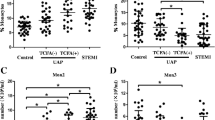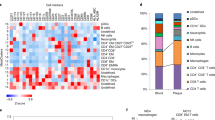Abstract
Background
Unstable atherosclerotic plaque typically contains an infiltrate of activated macrophages and activated T cells. This study established a functional profile of plaque-residing dendritic cells (DC) to examine whether they can function as Ag-presenting cells to facilitate in situ T-cell activation.
Methods
Carotid artery plaque tissues were collected from 19 asymptomatic and 38 symptomatic patients undergoing endarterectomy. Matched samples of normal coronary artery wall, stable nonruptured plaque, and eroded unstable plaque were harvested from patients with fatal myocardial infarction. Quantitative PCR and immunohistochemistry were used to analyze the tissues for markers of DC activation (CD83, CD86, CCL19,CCL21) and correlate them with T-cell activation (IFN-γ,TNF-α).
Results
Carotid artery plaques from patients with ischemic symptoms compared to asymptomatic patients were characterized by the presence of high amount of T-cells (P < 0.01) and tissue production of high levels of the T-cell cytokines IFN-γ (P = 0.001) and TNF-α (P = 0.006). Plaque tissues from patients with ischemic complications contained elevated levels of CD83 (P < 0.001), a marker of DC activation, and the DC chemokines CCL19 (P = 0.001) and CCL21 (P < 0.02).
Unstable coronary artery plaques were similarly correlated compared to carotid plaques from symptomatic patients with the accumulation of T cells (P = 0.001) and the production of T cell chemokines IFN-γ (P = 0.001) and TNF-α (P = 0.002).
Immunohistochemistry confirmed the presence of CD83+ DC in the shoulder region of unstable plaques, where they produced the T cell-attracting chemokines CCL19 and CCL21. Mapping of activated DC demonstrated close contact between mature DC and T cells expressing the activation marker CD40 ligand (CD40L).
Conclusion
Activated and fully mature DC are represented in the inflammatory infiltrate characteristic for unstable carotid and coronary atheroma. Such DC produce chemokines, and thus can regulate the cell traffic into the lesion. Through the expression of the costimulatory ligand CD86, plaque-residing DC can augment T-cell stimulation and provide optimal stimulation conditions for T lymphocytes, resembling the microenvironment in organized lymphoid tissues.
Similar content being viewed by others
References
Banchereau J, Steinman RM (1998) Dendritic cells and the control of immunity. Nature 392:245–252
Barger AC, Beeuwkes R, Lainey LL, Silverman KJ (1984) Hypothesis: vasa vasorum and neovascularisation of human coronary arteries: a possible role in the pathophysiology of atherosclerosis. N Engl J Med 310:175–177
Binder CJ, Chang MK, Shaw PX, Miller YI, Hartvigsen K, Dewan A et al. (2002) Innate and acquired immunity in atherogenesis. Nat Med 8:1218–1226
Bobryshev YV, Lord RS (1998) Mapping of vascular dendritic cells in atherosclerotic arteries suggests their involvement in local immune-inflammatory reactions. Cardiovasc Res 37:799–810
Bobryshev YV, Lord RS, Parsson H (1998) Immunophenotypic analysis of the aortic aneurysm wall suggests that vascular dendritic cells are involved in immune responses. Cardiovasc Surg 6:240–249
Bobryshev YV, Lord RS, Rainer S, Jamal OS, Munro VF (1996) Vascular dendritic cells and atherosclerosis. Pathol Res Pract 192:462–467
Bobryshev YV, Lord RS (2002) Expression of heat shock protein-70 by dendritic cells in the arterial intima and its potential significance in atherogenesis. J Vasc Surg 35:368–375
Buono C, Lichtman AH (2004) Co-stimulation and plaqueantigen-specific Tcell responses in atherosclerosis. Trends Cardiovasc Med 14:166–172
Buono C, Pang H, Uchida Y, Libby P, Sharpe AH, Lichtman AH (2004) B7-1/B7-2 costimulation regulates plaque antigen-specific T-cell responses and atherogenesis in low-density lipoprotein receptor-deficient mice. Circulation 109:2009–2015
Cheng GC, Loree HM, Kamm RD, Fishbein MC, Lee RT (1993) Distribution of circumferential stress in ruptured and stable atherosclerotic lesions. Circulation 87:1179–1187
Davies MJ, Thomas AC (1985) Plaque fissuring: the cause of acute myocardial infarction, sudden ischemic death, and crescendo angina. Br Heart J 53:363–373
Davies MJ (1990) A macro and micro view of coronary vascular insult in ischemic heart disease. Circulation 82:38–46
Davies MJ, Richardson PD, Woolf N, Katz DR,Mann J (1993) Risk of thrombosis in human atherosclerotic plaques: role of extracellular lipid, macrophage, and smooth muscle cell content. Br Heart J 69:377–381
Edfeldt K, Swedenborg J, Hansson GK, Yan ZQ (2002) Expression of Toll-like receptors in human atherosclerotic lesions: a possible pathway for plaque activation. Circulation 105:1158–1161
Falk E (1985) Unstable angina with fatal outcome: dynamic coronary thrombosis leading to infarction and/or sudden death: autopsy evidence of recurrent mural thrombosis with peripheral embolization culminating in total vascular occlusion. Circulation 71:699–708
Forster R, Schubel A, Breitfeld D, Kremmer E, Renner-Muller I, Wolf E et al. (1999) CCR7 coordinates the primary immune response by establishing functional microenvironments in secondary lymphoid organs. Cell 99:23–33
Frostegård J, Ulfgren AK, Nyberg P, Hedin U, Swedenborg J, Andersson U et al. (1999) Cytokine expression in advanced human atherosclerotic plaques: dominance of pro-inflammatory (Th1) and macrophage-stimulating cytokines. Atherosclerosis 145:33–43
Fujii S, Liu K, Smith C, Bonito AJ, Steinman RM (2004) The Linkage of Innate to Adaptive Immunity via Maturing Dendritic Cells in Vivo — Requires CD40 Ligation in Addition to Antigen Presentation and CD80/86 Costimulation. J Exp Med 199:1607–1618
Fuster V, Badimon I, Badimon JJ, Chesebro JH (1992) The pathogenesis of coronary artery disease and the acute coronary syndromes. N Engl J Med 326:242–250
Hansson GK, Libby P (1996) The role of the lymphocyte. In: Fuster V, Ross R, Topol EJ (eds) Atherosclerosis and coronary artery disease.Vol. 1. Philadelphia: Lippincott-Raven, pp 557–568
Jonasson L, Holm J, Skalli O, Gabbiani G, Hansson GK (1985) Expression of class II transplantation antigen on vascular smooth muscle cells in human atherosclerosis. J Clin Invest 76: 125–131
Kang YM, Zhang X, Wagner UG, Yang H, Beckenbaugh RD, Kurtin PJ et al. (2002) CD8 T cells are required for the formation of ectopic germinal centers in rheumatoid synovitis. J Exp Med 195:1325–1336
Krupa WM, Jeon MS, Spoerl S, Tedder TF, Goronzy JJ, Weyand CM (2004) Activation of Arterial Wall Dendritic Cells and Breakdown of Self-tolerance in Giant Cell Arteritis. J Exp Med 199:173–183
Lanzavecchia A (1996) Mechanisms of antigen uptake for presentation. Curr Opin Immunol 8:348–354
Libby P, Lee RTL (1995) Role of activated macrophages and T lymphocytes in rupture of coronary plaques. In: Braunwald E (ed) Heart Disease: A Textbook of Cardiovascular Medicine Philadelphia, Pa: Saunders WB, pp 191–195
Libby P, Hansson GK, Pober JS (1999) Atherogenesis and inflammation. In: Chien KR (ed) Molecular Basis of Cardiovascular Disease. Philadelphia: Saunders WB, pp 349–366
Liuzzo G, Kopecky SL, Frye RL, O’Fallon WM, Goronzy JJ, Weyand CM et al. (1999) Perturbation of the T-cell repertoire in patients with unstable angina. Circulation Nov 23; 100:2135–2139
Lutgens E, Gorelik L, Daemen MJAP, de Muinck ED, Grewal IS, Kotelianski VE et al. (1999) Requirement for CD154 in the progression of atherosclerosis. Nat Med 5:1313–1316
Lutgens E, Cleutjens KBJM, Heeneman S, Koteliansky VE, Burkly LC, Daemen MJAP (2000) Both early and delayed anti-CD40L antibody treatment induces a stable plaque phenotype. Proc Natl Acad Sci USA 97:7464–7469
Ma-Krupa W, Jeon MS, Spoerl S, Tedder TF, Goronzy JJ, Weyand CM (2004) Activation of arterial wall dendritic cells and breakdown of self-tolerance in giant cell arteritis. J Exp Med 199:173–183
Ma-Krupa W, Dewan M, Jeon MS, Kurtin PJ, Younge BR, Goronzy JJ et al. (2002) Trapping of Misdirected Dendritic Cells in the Granulomatous Lesions of Giant Cell Arteritis. Am J Pathol 161:1815–1823
Nakajima T, Goek O, Zhang X, Kopecky SL, Frye RL, Goronzy JJ et al. (2003) De novo expression of killer immunoglobulin- like receptors and signaling proteins regulates the cytotoxic function of CD4 T cells in acute coronary syndromes. Circ Res 25; 93:106–113
Perrin-Cocon L, Coutant F, Agaugué S, Deforges S, André P, Lotteau V (2001) Oxidized Low-Density Lipoprotein Promotes Mature Dendritic Cell Transition from Differentiating Monocyte. J Immunol 167:3785–3791
Raines EW, Rosenfeld ME, Ross R (1996) The role of macrophages. In: Fuster V, Ross R, Topol EJ (eds) Atherosclerosis and coronary artery disease. Vol 1. Philadelphia: Lippincott-Raven, pp 539–555
Randolph DA, Huang G, Carruthers C, Bromley LE, Chaplin DA (1999) The role of CCR7 in TH1 and TH2 cell localization and delivery of B cell help in vivo. Science 286:2159–2162
Ross R (1999) Atherosclerosis — an inflammatory disease. N Engl J Med Jan 14, 340:115–126
Rossi D, Zlotnik A (2000) The biology of chemokines and their receptors Annu Rev Immunol 18:217–242
Summers KL, Hock BD, McKenzie JL, Hart DNJ (2001) Phenotypic Characterization of Five Dendritic Cell Subsets in Human Tonsils. Am J Pathol 159:285–295
Virmani R, Kolodgie FD, Burke AP, Farb A, Schwartz SM (2000) Lessons from sudden coronary death: a comprehensive morphological classification scheme for atherosclerotic lesions. Arteroscler Thromb Vasc Biol 20:1262–1275
Weyand, CM, Kurtin PJ, Goronzy JJ (2001) Ectopic lymphoid organogenesis: a fast track for autoimmunity. Am J Pathol 159:787–793
Yilmaz A, Lochno M, Traeg F, Cicha I, Reiss C, Stumpf C et al. (2004) Emergence of dendritic cells in ruptureprone regions of vulnerable carotid plaques. Atherosclerosis Sep 176:101–110
Zernecke A, Weber C (2005) Inflammatory mediators in atherosclerotic vascular disease. Basic Res Cardiol 100:93–101
Author information
Authors and Affiliations
Corresponding author
Rights and permissions
About this article
Cite this article
Erbel, C., Sato, K., Meyer, F.B. et al. Functional profile of activated dendritic cells in unstable atherosclerotic plaque. Basic Res Cardiol 102, 123–132 (2007). https://doi.org/10.1007/s00395-006-0636-x
Received:
Revised:
Accepted:
Published:
Issue Date:
DOI: https://doi.org/10.1007/s00395-006-0636-x




